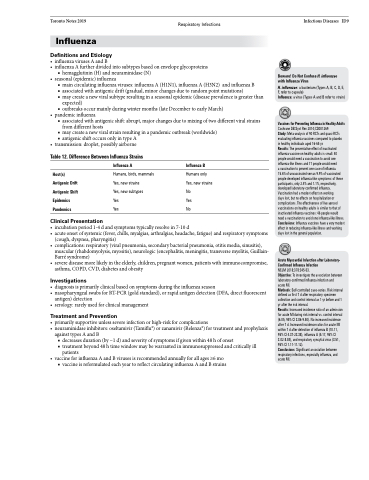Page 609 - TNFlipTest
P. 609
Toronto Notes 2019 Respiratory Infections Influenza
Definitions and Etiology
• influenzavirusesAandB
• influenzaAfurtherdividedintosubtypesbasedonenvelopeglycoproteins
■ hemagglutinin (H) and neuraminidase (N) • seasonal(epidemic)influenza
■ main circulating influenza viruses: influenza A (H1N1), influenza A (H3N2) and influenza B
■ associated with antigenic drift (gradual, minor changes due to random point mutations)
■ may create a new viral subtype resulting in a seasonal epidemic (disease prevalence is greater than
expected)
■ outbreaks occur mainly during winter months (late December to early March)
• pandemicinfluenza
■ associated with antigenic shift: abrupt, major changes due to mixing of two different viral strains
from different hosts
■ may create a new viral strain resulting in a pandemic outbreak (worldwide) ■ antigenic shift occurs only in type A
Infectious Diseases ID9
Beware! Do Not Confuse H. influenzae with Influenza Virus
H. influenzae: a bacterium (Types A, B, C, D, E, F, refer to capsule)
Influenza: a virus (Types A and B refer to strain)
Vaccines for Preventing Influenza in Healthy Adults
Cochrane DB Syst Rev 2014;CD001269
Study: Meta-analysis of 90 RCTs and quasi-RCTs evaluating influenza vaccines compared to placebo in healthy individuals aged 16-65 yr.
Results: The preventative effect of inactivated influenza vaccine on healthy adults is small: 40 people would need a vaccination to avoid one influenza-like illness and 71 people would need
a vaccination to prevent one case of influenza. 15.6% of unvaccinated versus 9.9% of vaccinated people developed influenza-like symptoms: of these participants, only 2.4% and 1.1%, respectively, developed laboratory-confirmed influenza. Vaccination had a modest effect on working
days lost, but no effects on hospitalization or complications. The effectiveness of live aerosol vaccinations on healthy adults is similar to that of inactivated influenza vaccines: 46 people would need a vaccination to avoid one influenza-like illness. Conclusions: Influenza vaccines have a very modest effect in reducing influenza-like illness and working days lost in the general population.
Acute Myocardial Infarction after Laboratory- Confirmed Influenza Infection
NEJM 2018;378:345-53.
Objective: To investigate the association between laboratory-confirmed influenza infection and acute MI.
Methods: Self-controlled case-series. Risk interval defined as first 7 d after respiratory specimen collection and control interval as 1 yr before and 1 yr after the risk interval.
Results: Increased incidence ratio of an admission for acute MI during risk interval vs. control interval (6.05, 95% CI 3.86-9.50). No increased incidence after 7 d. Increased incidence ratios for acute MI within 7 d after detection of influenza B (10.11, 95% CI 4.37-23.38), influenza A (5.17, 95% CI 3.02-8.84), and respiratory syncytial virus (3.51, 95% CI 1.11-11.12).
Conclusions: Significant association between respiratory infections, especially influenza, and acute MI.
• transmission:droplet,possiblyairborne
Table 12. Difference Between Influenza Strains
Host(s) Antigenic Drift Antigenic Shift Epidemics Pandemics
Clinical Presentation
Influenza A
Humans, birds, mammals Yes, new strains
Yes, new subtypes
Yes
Yes
Influenza B
Humans only Yes, new strains No
Yes
No
• incubationperiod1-4dandsymptomstypicallyresolvein7-10d
• acute onset of systemic (fever, chills, myalgias, arthralgias, headache, fatigue) and respiratory symptoms
(cough, dyspnea, pharyngitis)
• complications:respiratory(viralpneumonia,secondarybacterialpneumonia,otitismedia,sinusitis),
muscular (rhabdomyolysis, myositis), neurologic (encephalitis, meningitis, transverse myelitis, Guillain-
Barré syndrome)
• severediseasemorelikelyintheelderly,children,pregnantwomen,patientswithimmunocompromise,
asthma, COPD, CVD, diabetes and obesity
Investigations
• diagnosisisprimarilyclinicalbasedonsymptomsduringtheinfluenzaseason
• nasopharyngealswabsforRT-PCR(goldstandard),orrapidantigendetection(DFA,directfluorescent
antigen) detection
• serology: rarely used for clinical management
Treatment and Prevention
• primarilysupportiveunlesssevereinfectionorhigh-riskforcomplications
• neuraminidaseinhibitors:oseltamivir(Tamiflu®)orzanamivir(Relenza®)fortreatmentandprophylaxis
against types A and B
■ decreases duration (by ~1 d) and severity of symptoms if given within 48 h of onset
■ treatment beyond 48 h time window may be warranted in immunosuppressed and critically ill
patients
• vaccineforinfluenzaAandBvirusesisrecommendedannuallyforallages≥6mo
■ vaccine is reformulated each year to reflect circulating influenza A and B strains


